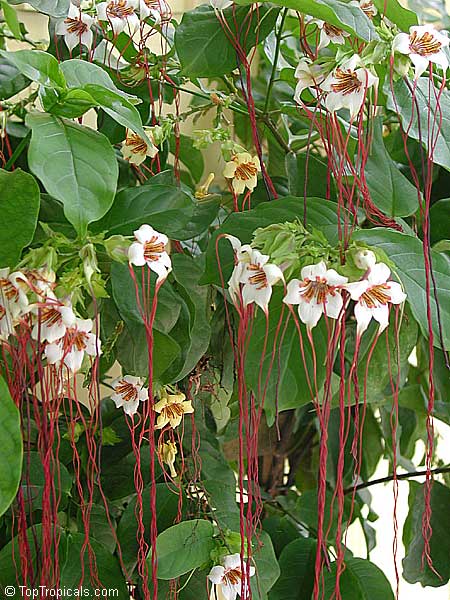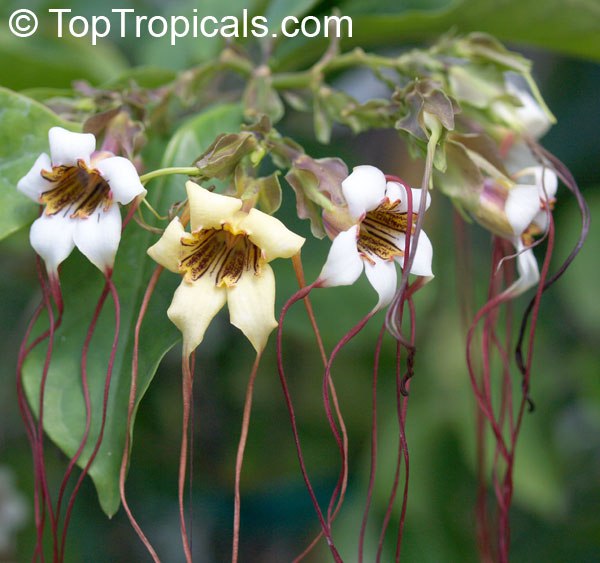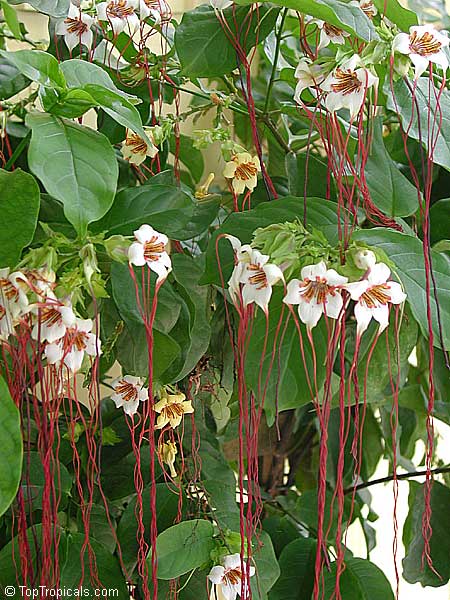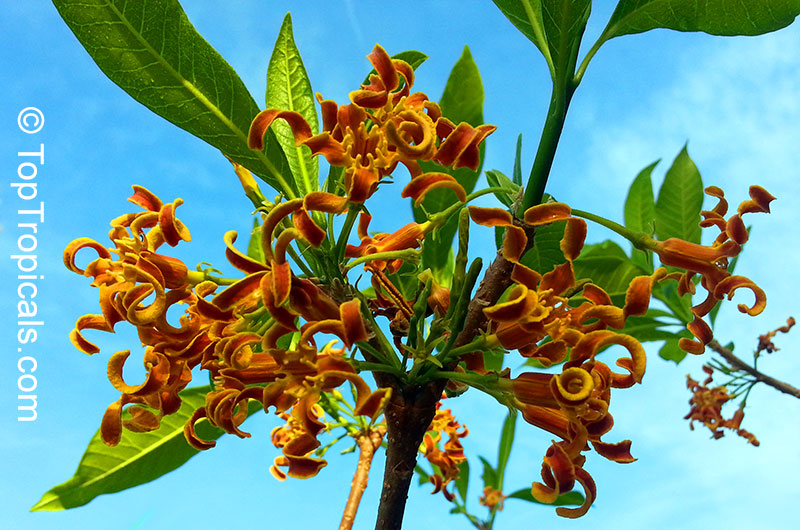Date:
How to get Strophanthus tree to bloom?
Q: I purchased from you three of these plants - Strophanthus bovinii and I wonder if you could help me. The plants are out of control growing large limbs to the sides and I would like it to grow more upright. Is this possible? Second, it does not flower. What type of fertilizer should I use and how often? How about the watering schedule? I have them in an eastern exposure but possibly they are not getting enough sun? Right in front of them, there is a large tree outside the curb of my house. What should I do about that?
A: Strophanthus bovinii - Wood shaving flower, is quite a unique plant
that is very rare in cultivation, this is why very little information is
available on its cultivation due to limited experience among gardeners. We have had
this plant in our garden for over 12 years and this is what we can advise.
In the nature (Madagascar) it supposedly grows into a large tree, however,
from our experience, it tends to be rather bushy, umbrella-like large shrub.
Yes, you can train it into a tree by trimming branches growing side-wise, and
by removing lower branches. The best time for pruning is early spring when
the tree starts new growth and re-leafs (it is semi-deciduous).
As far as flowering, the plant is very particular about blooming season,
with profuse flowering in Summer (here in SW Florida), however it may produce
more flowers sporadically throughout the year.
It thrives in full sun but will tolerate bright filtered light. If a large
tree is shading it too much, try to trim some limbs of that large tree to
allow more light. Water needs of Strophanthus bovinii are very moderate, so you
can rely on your sprinkler system or water once a week for established
plants.
You should use 2 types of fertilizers - slow release (once a month) and
water-soluble bloom booster (frequent applications are safe):
Pink N Good Daily Plant Food - Flower Booster
Tropical Allure - Smart-Release Booster
Medusas Head Flower - from Greek mythology
Strophanthus preussii - Poison Arrow Vine, Medusa Flower

Strophanthus preussii - Poison Arrow Vine, Medusa Flower

Strophanthus preussii - Poison Arrow Vine, Medusa Flower
- 🐙 Strophanthus preussii - Poison Arrow Vine, Medusa Flower - has an intriguing flower!
- 🐙 The faintly fragrant flowers have long, slender, and curly petals that resemble the snakes on Medusa's head from Greek mythology, giving it the nickname "Medusa Flower." The petals often extend and twist dramatically, creating an eye-catching appearance. The tips of the petals become narrowed and elongated, forming a twisting, sticky string that dangles down from the flower and touches lower leaves.
- 🐙 The flowers are brightly colored, often in shades of white, yellow, and red, which can attract pollinators and add to their striking visual appeal.
- 🐙 As suggested by another common name "Poison Arrow Vine," parts of the plant contain toxic compounds. Historically, the seeds were used by some African tribes to poison the tips of arrows for hunting. This gives the plant a certain mystique...
- 🐙 Interesting pollination mechanism: the elaborate design of the flowers is not just for show; it plays a role in the plant's pollination strategy. The intricate structure can help ensure that pollinators come into contact with the reproductive parts of the flower, thereby facilitating cross-pollination.
- 🐙 Blooms almost year around
❓ What bizarre plants do you have in your collection? Share in comments👇
🛒 Order Medusa Flower
#Hedges_with_benefits #Nature_Wonders #Butterfly_Plants
🏵 TopTropicals
This is not AI
Wood Chip Flower - Strophanthus bovinii
It's a real plant, called Wood Chip Flower - Strophanthus bovinii - blooming now in our garden.
@TopTropicals you will discover exotic plants you've never seen before:
🏵 Breathtaking flowers and perfume plants
Rare fruit trees from around the world
🌿 Ethnomedical herbs
✅ All you need to know about rare tropical plants, how to grow and use them, where to get them - in one TopTropicals channel.
We have them all.
👉 Subscribe and share:
TopTropicals - We Grow Happiness
Date:
Capricorn - 12/22 - 1/19.
An EARTH sign ruled by the planet Saturn. Capricorn's plants usually have few flowers, or small flowers, are knobby or woody, and may have an unpleasant smell or taste. Saturn rules plants with long lives and slow growth, so plants with annual rings are also associated with the Goat.
Physiologically, Saturn rules the systems that give the body its structure and form: the skeletal system, and the skin, teeth, joints, and knees, so plants that are high in calcium can be very beneficial. Those can be woody plants and shrubs that show annual rings, as well as some poisonous or narcotic plants. Saturn plants are useful in treating arthritis and rheumatism. Traditional Capricorn appreciates a spice that is powerful but familiar. Black pepper adds flavor and a bit of heat to both food and life, creating movement without too much change.
Capricorn Zodiac lucky plants:
Baobab, Peach Palm, Patchouli, Bamboo, Cordyline, Spider Lily, Serissa, Desert Rose, Croton, Aloe, Palms, Giraffe knee plant - Gonatopus boivinii, Adenanthera, Black Pepper, Solanums, Loquat, Aglaonema, Jacaranda, Rosemary, Shisham - Dalbergia sissoo, Neem Tree, Calendula, Brugmansia, Cannabis, Coca, Kava-Kava, Root Beer plant, Kratom, Banesteriopsis, Psychotria, Quince, Almonds, Ginkgo, Olive, Strophanthus, Bread Flower, Amorphophallus, Areca Palm, Anadenanthera, all Pipers, Brunfelsia, Chaya, Persimmons, Surinam Cherry, Bel Fruit, Ashoka Tree, Calla Lily.
For other signs information, see full Plant Horoscope.















